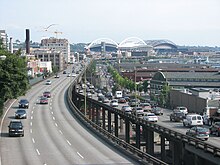Alaskan Way Viaduct
| Alaskan Way Viaduct | |
|---|---|

The Alaskan Way Viaduct, looking southeast
|
|
| Carries |
|
| Locale | Downtown Seattle, US |
| Characteristics | |
| Material | Concrete |
| History | |
| Construction end | April 4, 1953 |
| Statistics | |
| Daily traffic | 110,000 cars per day |
 |
|
The Alaskan Way Viaduct is an elevated highway in Seattle, Washington built in three phases from 1949 through 1953 and opened on April 4, 1953. It features a double-decked elevated section of State Route 99 that runs along the Elliott Bay waterfront in the industrial district and downtown of Seattle. It is the smaller of the two major north–south traffic corridors through Seattle (the other being Interstate 5), carrying up to 110,000 vehicles per day. The viaduct runs above the surface street, Alaskan Way, from S. Nevada Street in the south to the entrance of Belltown's Battery Street Tunnel in the north, following previously existing railroad lines.
The viaduct was damaged in the 2001 Nisqually earthquake. The initial phase of demolition and removal of the southern viaduct began on October 21, 2011. Boring of the Alaskan Way Viaduct replacement tunnel by the tunnel boring machine "Bertha" began in 2013 and is anticipated to open in 2019; the viaduct will be rebuilt to modern seismic standards for the industrial area south of downtown.
The 1989 Loma Prieta earthquake destroyed the similarly designed Cypress Street Viaduct in Oakland, California with the loss of 42 lives. The 2001 Nisqually earthquake damaged the viaduct and its supporting Alaskan Way Seawall and required the Washington State Department of Transportation (WSDOT) to invest US$14.5 million in emergency repairs. Experts give a 1-in-20 chance that the viaduct could be shut down by an earthquake within the next decade. Since the Nisqually Earthquake occurred, semi-annual inspections have discovered continuing settlement damage.
...
Wikipedia
